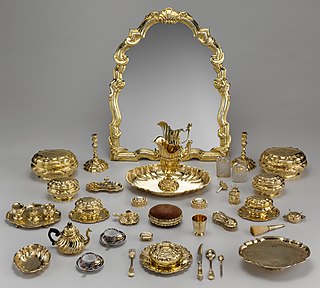
Household silver or silverware includes tableware, cutlery, and other household items made of sterling silver, silver gilt, Britannia silver, or Sheffield plate silver. Silver is sometimes bought in sets or combined to form sets, such as a set of silver candlesticks or a silver tea set.

Ben Quilty is an Australian artist and social commentator, who has won a series of painting prizes: the 2014 Prudential Eye Award, 2011 Archibald Prize, and 2009 Doug Moran National Portrait Prize. He has been described as one of Australia's most famous living artists.

Louisa Perina Courtauld was a French-born English silversmith.

Hester Bateman was an English silversmith, renowned for her high quality flatware and ornamental silverware. A craftswoman working within the family business, she was succeeded in turn by her sons, daughter-in-law, grandson and great-grandson. The Bateman family silversmithing company lasted until the middle of the nineteenth century.
John Schuppe was a Dutch silversmith working in London and noted for his humorous cow creamers.
Alice Burrows was an English silversmith.
Mary Chawner, néeBurwash, was an English silversmith.
Elizabeth Cooke was an English silversmith.
Ann Craig was an English silversmith.
Mary Ann Croswell was an English silversmith.
Mary Gould was an English silversmith.
Elizabeth Jones was an English silversmith.
Elizabeth Muns was an English silversmith.
Mary Rood or Roode was an 18th-century English silversmith.
Ann Robertson was an English silversmith.
Alice Sheene was an English silversmith.
Jane Williams was an Irish silversmith.
Elizabeth Tookey was an English silversmith.
Dorothy Sarbitt was an English silversmith; she also produced work under the name Dorothy Mills.
Kay Lindjuwanga is an Aboriginal Australian artist from Maningrida in the Northern Territory of Australia. She is known for her bark paintings which often make use of Aboriginal rrark designs.




